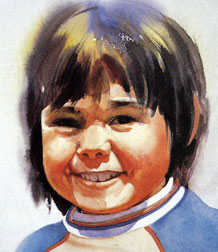The fine art of painting skin and hair
by Tissa Hewavitarane
One of the many problems the portrait painter has to face is dealing
with what are virtually two opposites in terms of texture. The bark of a
tree or the fur of an animal is a relatively uniform texture, but human
skin is entirely different from human hair, giving the artist the task
of finding the technique that can equally express them.
|

A watercolour painting |
If you were to use the meticulous dry brush water colour technique
for the hair and a fluid wet-in-wet for the face, the effect would be
bizarre and unpleasing though each of these techniques would be
perfectly appropriate in the context.
The varying textures of skin and hair have always presented a
challenge artists and anyone interested in portrait painting will need
to consider.
For instance, you do not give the impression of the soft skin of a
child suggesting the rougher, more lined skin of a middle-aged person or
the intricacy of frizzy unruly hair. Different drawing materials can
also be useful in showing textured hair. When adding tone to your
drawing use the pencil experimentally to try out different effects.
Elusive
Of all the textures the skin is the most subtle and elusive. Painting
it to look alive is one of the greatest challenges to the painter's
skill. The most dramatic changes in the texture of skin are wrought by
time. The skin of a baby or a young child is soft and ‘peachy’ unlike
that of an old person.
But this is not all. The texture also varies according to the part of
the body in an adult's hands and faces constantly exposed to the air.
They are nearly always rougher than the torso, covered by the protective
layer of clothing for most of the time.
The skin stretched tightly over a bone, such as the nose or forehead,
is smoother and more reflective than the layer of flesh and fat below.
These are just some of the differences you can readily observe in any
person.
When you are painting you need to be aware of the colours of the
flesh because it can provide important clues about the texture. Older
skin is usually darker in colour than that of a young person. An other
important clue, however is the quality of the highlights.
Highlights
The highlights will usually be brighter on drier “dustier” skins,
where it will be more diffused. When painting, look out for these
highpoints of light as they are extremely important indicators of form
as well as texture. They usually occur at corners or where a plane
changes direction. For example, on the forehead where the two planes of
the head meet, or the top of the lip, where the flesh of the lips begin
to turn.
There is such a range of texture and styles seen on the human head
that it is impossible to explain the changes about them, but these are
some points.
When you are painting the most important factor to ensure is that you
relate the hair to the head itself. This sounds obvious, but if your
subject has an elaborate hairstyle it is only too easy to become so
involved in the intricacies of curls and waves that you forget about the
shape of the skull beneath and the way the hair relates to the face.
Brush strokes
Look out for the weight of the hair, as this is important in giving
shape to the style, even in the case of short hair. All hair stylists
know that thick heavy hair holds its shape better than thin, wispy hair
and it is even easier for artists to paint, as you can simplify the
forms using long sweeping brush strokes.
Thin frizzy or ‘flyaway’ hair is trickier because it does not always
follow the shape of the head precisely, and is in general more demanding
in terms of technique.
For a painter the most important characteristic of all is to look out
for the sheen of the hair, the highlight giving the vital textural
clues. Dark oily hair will have very pronounced highlights, thick dry
hair diffused ones and thin dry or frizzy hair will bear almost no
recognisable highlights.
Strands of hair
In painting and drawing fine strands of hair is to use a technique of
impressing thin lines into the paper with a sharp pointed brush. This
method requires a lot of practice and a little planning ahead to ensure
that the lines will be in the right relationship to the rest of the
drawing, and the results can make it worthwhile.
Use a fairly thick drawing paper and begin the drawing by impressing
those strands of hair you want to reserve as white with a fine metal
point such as a nail not so sharp that it will cut the paper.
Although many successful portrait painters use watercolour. It is not
the easiest medium to handle for a subject. It is difficult in any case
for the beginner in watercolour.
He is advised to practise before embarking on a human subject. Notice
the painting done here. The mass of the hair is painted loosely using
the wet-in-wet technique with crisper wet-on-dry brush strokes over the
forehead.
|

